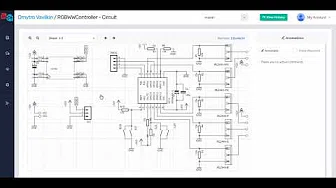Files
Scanning the repository...
| Files | |
|---|---|
| EE | |
| FW | |
| ME | |
| Media | |
| .gitignore | |
| readme.md | |
| repo.py | |
| tasks.py | |
| tasks_doc.py | |
| usbtiny.py |
readme.mdView this project on CADLAB.io.
Firmware
Compiler
sudo apt install make gcc-avr avr-libc avrdudeProgrammer
WSL USB
Note Simplexity documentation on forwarding USB to a Docker container in WSL.
Overview of WSL USB access.
Install the WSL drivers for your kernel.
- Open a WSL terminal and run
usbipd list. This will display packages that need to be installed for your WSL kernel. - Install those packages.
- Open a WSL terminal and run
Install the programmer Windows driver & plug in the programmer.
- Windows device manager should now show
libusb-win32 devices -> USBtiny
- Windows device manager should now show
Make the USB device available to WSL
- Open a WSL shell.
- List available USB devices:
usbipd.exe list. Find theUSBtinydevice and note the bus ID.- Note: This is calling a Windows executable from WSL.
- Attach the USB device to WSL:
usbipd.exe wsl attach --busid <bus ID>. The device should now be available in WSL.- When you're done with the device, detach with the command above, substituting
detachforattach.
- When you're done with the device, detach with the command above, substituting
- Verify the device is available in an WSL terminal:
lsusb. The device should be listed.
Create a
udevrules file to make the device accessible toavrdude.After attaching the device to WSL per above, run
lsusbto get theidVendorandidProductvalues needed next. The output should look something like this:Bus 001 Device 002: ID 1781:0c9f Multiple Vendors USBtinyIn this example (default for the usbtiny programmer), the
idVendoris1781and theidProductis0c9f.Create a file
/etc/udev/rules.d/99-usb.ruleswith the following contents:SUBSYSTEM=="usb", ATTR{idVendor}=="1781", ATTR{idProduct}=="0c9f", MODE="0660", GROUP="plugdev"- The
idVendorandidProductvalues are from the output ofusbipd listabove.
- The
- Add your user to the group. This will require logging out and back in.
sudo usermod -a -G plugdev $USER - Reload the
udevrules:sudo udevadm control --reload-rules && sudo udevadm trigger
NOTE: If you're unable to access, try with
sudopermissions.
https://devblogs.microsoft.com/commandline/connecting-usb-devices-to-wsl/
https://www.krekr.nl/content/using-usbtinyisp-with-ubuntu/ https://www.tonymitchell.ca/posts/programming-avr-in-wsl-tips-and-tricks/
Simulator
sudo apt install simavr
also installs gdb-avr as a dependency.
To run a simulation, you need a special build that brings in simulator symbols.
See main-sim.c
make sim
If you run the simulator with the -g flag, it will open up a gdb server port.
You can then attach a GDB session to that port.
Debugger
- VSCode launch target defined in
.vscode/launch.json make sim-debugto build the debug target and lanch the gdb-avr server process.- Needs to be redone every code change.
- Make sure to kill the debugger if you relaunch.
- Select the VSCode debug and run with the AVR Debug configuration.
Electronics
AtTiny85
Amazon * \$13.29 for 5 pieces = $2.66/piece, though had free deliverey. * Digikey has for \$1.66/piece in quantity 1, $1.52 in quantity 25.
Servo Motor
Poteniometer
You may need to install the following packages for this specific kernel: linux-tools-5.15.90.1-microsoft-standard-WSL2 linux-cloud-tools-5.15.90.1-microsoft-standard-WSL2
You may also want to install one of the following packages to keep up to date: linux-tools-standard-WSL2 linux-cloud-tools-standard-WSL2








